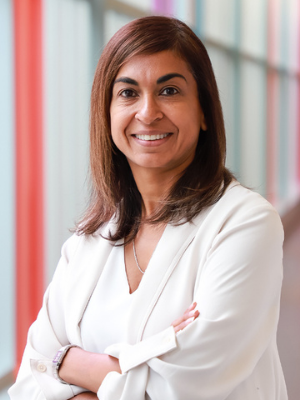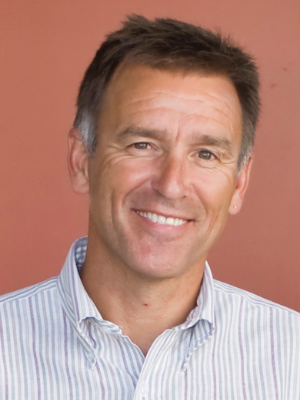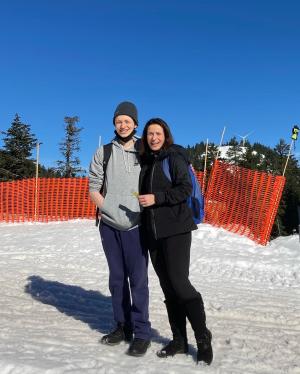BC Children’s Hospital researchers are recruiting young athletes across the province for a study to help improve prevention, diagnosis and treatment of concussions in youth sport.
“It’s every parent’s worst fear,” remarks Xanthe Brown. And in early December, that fear came true for the second time. Xanthe remembers sitting on the sidelines, watching her 16-year-old son Zach Abernethy play hockey. A player on the other team checked him from behind. Zach slammed headfirst into the boards.

“He came off the ice, and he was quite dazed and confused. He doesn’t really remember what happened on the ice, but I saw it all,” she says with emotion.
This was the Grade 11 student’s second concussion. The first one happened at a lacrosse game in 2017, and Zach felt symptoms for weeks — a constant headache that made it difficult for him to even be in the car, let alone focus in school. So he knew right away he had suffered another concussion.
But this time, there was a big difference in what happened afterward because the athletic teen had enrolled in a research study to improve concussion care for children and youth, just before the pandemic started.
Concussions far more common in kids and youth

The UBC site of the cross-Canada project is led by BC Children’s Hospital investigators Dr. Shelina Babul and Dr. Ian Pike. Funded by the National Football League Scientific Advisory Board, the SHRed Concussions program — short for Surveillance in High Schools to Reduce Concussions and Consequences of Concussions in Youth — provides a national platform for concussion surveillance in high schools. The goal is to reduce the risk of sport-related concussions and improve prevention, diagnosis and treatment.
“No two concussions are alike, no one responds the same, and we don’t quite know why yet,” says Dr. Babul, who is also the associate director at the BC Injury Research and Prevention Unit. “Concussions are more common in kids and youth than in adults, and over half of the concussions in youth in North America are from sport-related injuries. We really want to understand the risk factors.”

The latest statistics show about 46,000 children aged 5 to 19 in Canada are diagnosed in a hospital emergency department with a concussion each year. That doesn’t include any children who visit a family doctor or walk-in clinic, or just manage it on their own. Overall, it’s the most common form of head injury caused by an impact or forceful motion of the head or other part of the body, resulting in rapid movement of the brain within the skull.
Emerging evidence shows that even after concussion symptoms improve, and people are cleared to return to play, there can be lingering changes in the brain.
“That’s why we want to track these young individuals,” says Dr. Babul. “The intricate information highways of the brain are still making connections and developing. We don’t want kids and youth to have long-term effects.”
Study participants get fast-tracked concussion care
Recruitment for the study was halted because of COVID-19. Now, the study team is ramping up efforts to enrol more kids in B.C. between the ages of 13 to 17 who play one of these high-impact sports: basketball, football, ice hockey, ringette, lacrosse, rugby, soccer, volleyball, cheerleading, alpine skiing, sledge hockey and wrestling.
Participants have an initial assessment, and then they keep a weekly log of their activities and any injuries. If they have a concussion during the two-year study period, they will have access to specialized medical care within 48 hours. This could include MRI scans, blood tests and other assessments until they are fully recovered. The follow-up care participants get in the study is far more rigorous than the current standard in our province.
“Right now, if you get a concussion, you might go to your family physician. But a full concussion assessment takes about 45 minutes and the family physician may not have enough time,” explains Dr. Babul. “Guidelines and evidence are also changing constantly, so it can be challenging to keep up with that as well.”
For example, many people still believe they should not do any physical activity until all their concussion symptoms are gone. But actually, the latest guidelines recommend slowly resuming exercise after the first 48 hours. (Dr. Babul created the Concussion Awareness Training Tool, an excellent, science-based resource.)
Returning to play is the ultimate goal

After his second concussion, Zach did go to his family doctor. But the doctor simply told him to take two weeks off. He and his mom also called the SHRed team. Within a couple of days, they met with a specialist in concussions, and a few days later, Zach had an MRI scan of his brain. There was a follow-up scan a month later, and Zach was cleared to return to play. He will get another follow-up scan after three months.
“A neuroradiologist looked at the MRI scan images and said there weren’t any incidental findings. I really appreciated the assessment from an expert, and it made me feel a lot better about letting Zach get back on the ice,” says Xanthe. “I also think it’s a good opportunity to help other families down the road. When I look back from Zach’s first concussion in 2017 to now, there is so much more knowledge about concussions.”
“It was a really good opportunity and really reassuring to know that a specialist was taking care of me,” adds Zach.
And for the honour roll student who wants to study engineering after high school, there’s another big bonus in being part of the study. It’s hard for his mom to argue with the top experts in concussions about returning to play. He laughs, “It helps with negotiations with my mom!”
------------------------------




